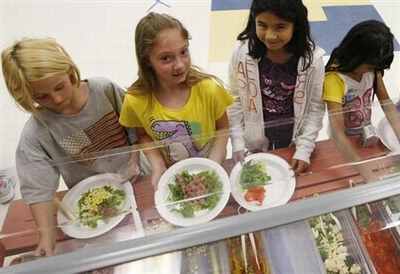
In 2010, Congress passed legislation designed to improve child nutrition. Schools have until July 1, 2014, to implement the rules outlined on Thursday.
The regulations, originally due in 2011, largely mirror the U.S. Department of Agriculture's February proposal that limited the fat, salt and sugar content in school snacks and capped portion sizes.
School food administrators fretted about implementing the changes, some groups said the rules were inadequate, and the jury was still out among the target audience - children.
"I see a lot of my friends eating unhealthy lunches," said Max Parsons, a 9-year-old elementary school student in Maryland. "Some of my friends I know won't miss it, but I don't know about the others."
Many U.S. children eat more than half of their daily calories at school. The regulations will cover about 50 million children attending more than 100,000 schools that are part of the federal school lunch program.
The standards only apply to foods and beverages sold on school campuses during the day, and limit vending machine snacks to a maximum of 200 calories per item - less than many regular-sized candy bars.
"It's supporting what moms and dads are doing all across the United States," Agriculture Secretary Tom Vilsack said in a call with reporters.
USDA gave the public 60 days to comment after it released its proposals in February. The final guidelines, while mostly unchanged, have incorporated a stricter calorie limit on drinks in high schools.
Twelve-ounce drinks cannot exceed 60 calories, less than the calorie count of most sodas.
And the portion sizes vary between age groups. Younger students will be able to buy water, 100 percent juice, and low-fat and fat-free milk in 8-ounce servings, while high school students can also purchase 20-ounce calorie-free drinks.
Food sold at after-school activities, such as sporting events, is not subject to the regulations.
A HISTORIC SHIFT
By improving the choices available to U.S. students outside of breakfast and lunch, officials hope to make a dent in childhood obesity in a nation where one-third of those under age 18 are considered overweight or obese.
Obesity is one reason some young adults cannot join the military, so improving food options in schools will also strengthen the nation's armed forces, said Lieutenant General Norman Seip, a member of Mission: Readiness, a group of retired military leaders.
All foods sold must meet competitive nutrient standards, meaning they must have fruits, vegetables, dairy or protein in them, or contain at least 10 percent of the daily value of calcium, potassium, vitamin D or dietary fiber.
"This is an historic nutrition policy that will do a lot to improve children's diets and address high rates of childhood obesity," Margo Wootan, director of nutrition policy at the Center for Science in the Public Interest, told Reuters.
But Sandra Ford, head of the School Nutrition Association which represents school food service workers in school districts nationwide, said the "complex regulations" could burden schools already working to offer healthier menus. Many schools are still working to push though earlier regulations overhauling school meals like breakfast and lunch.
Some parents, worried about snacks that undercut their efforts to provide healthy options, said the snack rules were a positive step, but more needs to be done.
Karen Devitt, co-founder of Real Food For Kids - Montgomery, a Maryland-based advocacy group aimed at improving foods at schools in Montgomery County, near Washington, D.C., said the USDA effort allows sugary juices and does not address other issues such as caffeine content and chemical additives.
"It's natural sugar, but it's not anywhere near eating a real piece of fruit," Devitt, who has a school-age daughter, told Reuters.
The guidelines set a minimum standard for snacks, meaning schools can implement stricter rules.
For Vilsack, improving children's food options is a personal issue. He has spoken often of his own experiences as an overweight child.
"You really can't concentrate and you cannot be the student you were intended to be if you are worried about what people think of you, so weight has always been an issue for me," Vilsack said in a speech in Portland, Maine in March.







